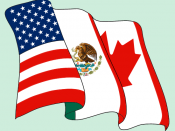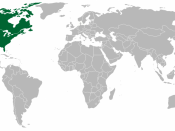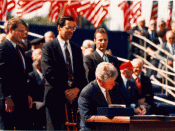International Economics Term ProjectRegional Trade ArrangementsTable of ContentsTypes of Regional Trade ArrangementsFree Trade AgreementCustoms UnionCommon MarketEconomic UnionRegional Trade Arrangements: Case StudiesNAFTAEUGCC UnionBenefits and Costs of Regional Trade ArrangementsWelfare Effects of Regional Trade ArrangementsStatic Effects of RTAsDynamic Effects of RTAsConditions inducing Regional Trade ArrangementsWorld Trade Organization and Regional Trade ArrangementsMultilateralism vs. RegionalismThe RTA and WTO RelationshipReferencesI- Types of Regional Trading ArrangementsA- Free Trade Agreement:The main functions of a free trade agreement are eliminating tariffs on goods, abolishing of trade barriers such as restrictive regulation on trade in services. For the free trade agreement, member countries donæ° establish common tariffs of outside signatories, so that each member country establishes certain trade restraints to outsiders independently. Moreover, one of the most important functions of the free trade agreement is establishing a stiff political and cultural relationship among member countries.
The free trade agreement is provided by GATT (The General Agreement on Tariffs and Trade) article 24 of general agreements regarding customs and trading and GATS (The General Agreement on Trade in Services) article 5 of general agreements regarding trade in services.
By 2002, more than 130 of schemes for the free trade agreements are reported to the WTO. Major examples of the free trade agreements are the following: NAFTA (The North American Free Trade Agreement), CEFTA (Central European Free Trade Agreement), and SAFTA (The South Asia Free Trade Agreement). In addition, the free trade agreements are usually established among 2 nations; however, there are some multinational free trade agreements.
B- Customs UnionIn general, the functions of a customs union are based on free trade agreement -- eliminating tariffs on goods, abolishing of trade barriers such as barrier to trade in services. Moreover, for the customs union, member countries set common external trade restraints such as tariffs and quotas to...


